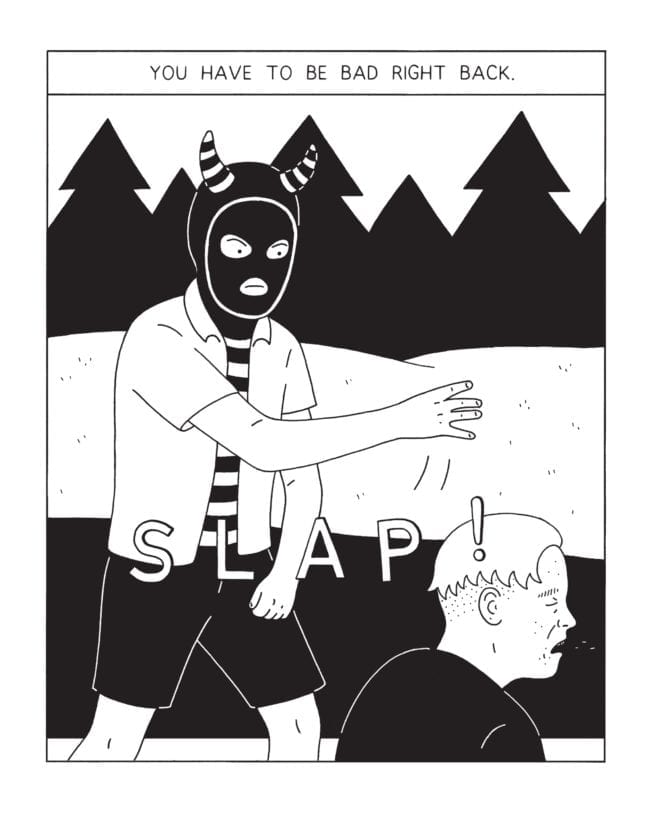The Bald Knobbers were a vigilante group active in southwest Missouri during the 1880s. They wore black hoods with pointy horns that must have looked positively Mephistophelian in flickering torchlight – one imagines that was quite the point. The Bald Knobbers were not, as many other vigilante groups originating in this period, fighting against Reconstruction, but against the general lawlessness that followed the war across across much of the country. The original Bald Knobbers were ex-Union men who came together under cover of darkness to bring order to their county.
Just a glance at the history indicates a familiar story. The public turned against them after early successes: the Bald Knobbers had been formed to take on bushwhackers and marauders but eventually they earned their very own group of Anti-Bald Knobbers, ex-Confederates spoiling for a fight. You can probably guess the rest. Missouri residents got sick of dueling gangs of masked men, incidents of vigilantism became less common, and in time the saga faded into the lore of local color. Why they haven’t been a movie is anyone’s guess.
Robert Sergel’s graphic novella Bald Knobber begins in the present day with a kid named Cole giving a book report about the group. He pulls on a homemade replica of the Bald Knobber mask, a ski mask with ringed devil horns emerging from either side of his head. In the light of day it’s any Halloween costume, at once ominous and ludicrous. Cole isn’t having a good time of it. His parents split, his dad’s a mess, and his mom’s dating a guy who works at the gas station. Which is the kind of thing that really sucks when you’re in school, no doubt, but walking around the neighborhood in his Knobber mask for the purpose of smacking around the bullies really isn’t going to improve the situation.
 Bald Knobber distinguishes itself for being a narrative about masked vigilantism in comic book form that avoids any clear parallels to super hero material. There’s one reference to his mask being “Janky Batman,” which is fairly descriptive, but also a telling anachronism. The fact that Bald Knobber is about a disgruntled kid who puts on a mask and sets about to beat up a bully without echoing any spandex tropes is impressive. That’s the point of the book, really – there’s nothing at all good about vigilantism, no nostalgia to be mined, just weird and shady shit from dark chapters of the nation’s history. The point isn’t particularly subtle but it’s not particularly trying to be: Cole puts on a mask and acts out, and this acting out earns him scorn and distrust.
Bald Knobber distinguishes itself for being a narrative about masked vigilantism in comic book form that avoids any clear parallels to super hero material. There’s one reference to his mask being “Janky Batman,” which is fairly descriptive, but also a telling anachronism. The fact that Bald Knobber is about a disgruntled kid who puts on a mask and sets about to beat up a bully without echoing any spandex tropes is impressive. That’s the point of the book, really – there’s nothing at all good about vigilantism, no nostalgia to be mined, just weird and shady shit from dark chapters of the nation’s history. The point isn’t particularly subtle but it’s not particularly trying to be: Cole puts on a mask and acts out, and this acting out earns him scorn and distrust.
There’s more packed in this deceptively small book than seems readily apparent. Bald Knobber isn’t a particularly violent book, in that the only real fighting is between grade school kids, but it’s set in the shadow of violence. There’s something intrinsically absurd about gangs of masked men going to war against one another, especially so when we’re discussing actual human beings from our own country’s actual history. The uncomfortable truth with which Bald Knobber leaves the reader is the assertion that much of this country’s history is the history of violence smoothed over not by justice but by time. (Hint: Google the real Bald Knobbers after you read the book and see if any of the names jump out at you.)
 Sergel’s art is controlled and precise. Blacks are solid, no crosshatching or gray scale employed. There’s a lot of dynamic play between positive and negative space that helps pull the reader’s eye across the page. The “awkward clean line,” for lack of a better term, familiar from like-minded artists like Nick Drnaso and (I suspect) ultimately descended from Chris Onstad’s deadpan distillation of Chris Ware, is not perhaps the most flexible style, but these tales of suburban anomie nevertheless hit raw nerves. The sense of rigid claustrophobia emanating from shabby circumstances saturated with ambient violence seems very much of the moment, and the current moment perhaps closer to the circumstances of the original Bald Knobbers than we’d care to comment.
Sergel’s art is controlled and precise. Blacks are solid, no crosshatching or gray scale employed. There’s a lot of dynamic play between positive and negative space that helps pull the reader’s eye across the page. The “awkward clean line,” for lack of a better term, familiar from like-minded artists like Nick Drnaso and (I suspect) ultimately descended from Chris Onstad’s deadpan distillation of Chris Ware, is not perhaps the most flexible style, but these tales of suburban anomie nevertheless hit raw nerves. The sense of rigid claustrophobia emanating from shabby circumstances saturated with ambient violence seems very much of the moment, and the current moment perhaps closer to the circumstances of the original Bald Knobbers than we’d care to comment.







